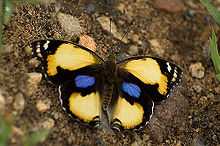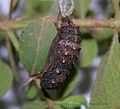Junonia hierta
| Yellow pansy | |
|---|---|
 | |
| Male | |
-_Female_in_Talakona_forest%2C_AP_W_IMG_8579.jpg) | |
| Female | |
| Scientific classification | |
| Kingdom: | Animalia |
| Phylum: | Arthropoda |
| Class: | Insecta |
| Order: | Lepidoptera |
| Family: | Nymphalidae |
| Genus: | Junonia |
| Species: | J. hierta |
| Binomial name | |
| Junonia hierta (Fabricius, 1798)[1] | |
| Synonyms | |
| |
Junonia hierta, the yellow pansy, is a species of nymphalid butterfly found in the Palaeotropics. It is usually seen in open scrub and grassland habitats.
Description
- See glossary for terms used.
The male upperside is bright yellow. The costa of the forewing has a broad triangular jet-black projection downwards at the discocellulars, and the dorsum has a triangular projection upwards near the tornus; this black margin narrows near the middle of the termen and bears on the apex two short transverse preapical white streaks crossed by the black veins. Below these is an obscure ocellus that is sometimes absent. The anterior half and the terminal margin of the hind wing is black, and the dorsum is broadly shaded with brown while the anterior black area has a large brilliant blue spot. The cilia of both fore and hind wings are white alternated with brown.
The underside of the forewing is pale yellow. The cellis is crossed by three laterally black-margined orange-yellow bars, beyond that is a short, broad, irregular jet-black oblique band from costa to base of vein 4. The hind wing is greyish yellow, and in the dry-season its form is strongly irrorated with dusky scales. With a prominent transverse brown discal fascia, its margins are highly sinuous. There is a brownish broad shade on the middle of the termen and some obscure lunular marks on the basal area. The antennae is pale, and the head, thorax and abdomen are dark brownish black; beneath that is a dull ochraceous white.
The female is similar, although the colours are duller. The cell of the upperside fore wing has a more or less complete transverse black fascia and another at the discocellulars. A blue-centred well-marked ocelli is in interspaces 2 and 5 on the disc of the fore wing, and smaller ocelli in interspaces 2 and 5 on the disc of the hind wing. The fore and hind wings have a fairly well-defined pale subterminal line, though the blue spot on the anterior black area on the hind wing is small and ill-defined; the rest is as the male. The underside is also as the male, but generally has heavier and more clearly defined markings.[2]
Larva and Pupa
The larva has a "Ground-colour dark brown or grey with a broad dorsal stripe formed of minute white and blue spots, spines black." (Davidson & Aitken) The pupa is dull reddish, with an obtuse head in front. The thorax is dorsally convex and the abdomen has a dorsal and lateral row of small blackish points" (Moore) [2]
-

Caterpillar
-

Pupa
-
-_Female_in_Talakona_forest%2C_AP_W_IMG_8586.jpg)
Imago, ventral view
Distribution
This species can be found in Africa and Southeast Asia.
Subspecies
|
References
See also
| Wikimedia Commons has media related to Junonia hierta. |
| Wikispecies has information related to: Junonia |
